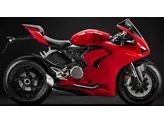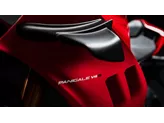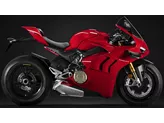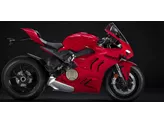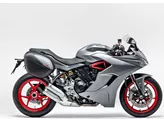Ducati Panigale V4 S 2018 vs. Yamaha R1 2016

Ducati Panigale V4 S 2018

Yamaha R1 2016
Overview - Ducati Panigale V4 S 2018 vs Yamaha R1 2016
The Ducati Panigale V4 S 2018 and the Yamaha R1 2016 are both high-performance supersport motorcycles that offer impressive power and advanced technology.
In terms of engine specifications, the Panigale V4 S has a larger displacement of 1103cc compared to the R1's 998cc. This results in a higher engine power of 214 HP for the Panigale V4 S compared to the R1's 200 HP. The Panigale V4 S also has a higher torque of 124 Nm compared to the R1's 112.4 Nm. Both motorcycles have a 4-cylinder engine with 4 valves per cylinder, but the Panigale V4 S features Desmodromic valves, while the R1 has DOHC valves.
In terms of suspension, both motorcycles feature upside-down telescopic forks at the front. The Panigale V4 S has a monocoque frame made of aluminum, while the R1 has a Deltabox frame, also made of aluminum.

Ducati Panigale V4 S 2018
Both motorcycles have double disk brakes at the front, providing excellent stopping power. The Panigale V4 S is equipped with an advanced rider assistance system, ABS, while the R1 goes a step further with additional features like launch control and traction control.
In terms of dimensions and weights, the Panigale V4 S has a slightly longer wheelbase of 1469mm compared to the R1's 1405mm. The seat height of the Panigale V4 S is 830mm, while the R1 has a higher seat height of 855mm. The Panigale V4 S has a slightly lower kerb weight of 195kg compared to the R1's 199kg. Both motorcycles have a fuel tank capacity of around 16-17 liters.
Now, let's discuss the strengths of each motorcycle. The Panigale V4 S is known for its dreambike image and excellent brakes. It offers a pleasant seating position, even for taller riders, and has an enormous lean angle potential. The Panigale V4 S also boasts a leading electronics package and an impressive engine power that is finely controllable. It is suitable for both fast riders and hobby riders, as it can be utilized within the scope of their abilities. The handling of the Panigale V4 S is also highly praised, as it allows the bike to finish the bend early and be ready for acceleration.
On the other hand, the R1 is known for its lively handling and high-revving, precisely controllable engine. It also features an excellent electronics package, including launch control and traction control.

Yamaha R1 2016
However, both motorcycles have their weaknesses. The Panigale V4 S has a seat that warms up noticeably, which can be uncomfortable in summer. The seat-tank combination also offers little grip in the braking zone. Additionally, stability at the limit can be a concern, requiring caution with tuning measures and discipline with seat position on fast and bumpy sections.
The R1's main weakness is that its shift assistant is only available for upshifting, lacking the convenience of a downshifting feature.
In conclusion, the Ducati Panigale V4 S 2018 and the Yamaha R1 2016 are both powerful and technologically advanced supersport motorcycles. The Panigale V4 S offers a larger displacement and higher engine power, while the R1 excels in lively handling and precise engine control. Both motorcycles have their strengths and weaknesses, catering to different preferences and riding styles.
Technical Specifications Ducati Panigale V4 S 2018 compared to Yamaha R1 2016
Pros and Cons in comparison
Pros and Cons in comparison
Ducati Panigale V4 S 2018

The S version, on the other hand, is recommended for both road and racing riders. If the bike is ridden more ambitiously by a racer on the race track, the suspension will maintain its performance longer than with the basic version, whereby a slight adjustment of the front spring rate (for racers) is recommended. The lighter wheels have a noticeable effect on the handling. It is unbelievable to what a high level of innovation and technology in motorbike construction this bike has been raised. I have never experienced electronics that respond so sensitively.
Yamaha R1 2016

Yamaha's high-tech rocket is still a technological leader in 2016. Radical, polarising and fascinating, it sets powerful lap times. It is closer to the race bikes than the other 1000s. In the meantime, no one grumbles about the front. Without the "M", it is the best choice for those who don't need Öhlins anyway, or the best choice for those who are planning a racetrack conversion anyway and like to install "normal" Öhlins hardware without electric stuff.
Price Comparison Avarage Market Price Ducati Panigale V4 S vs Yamaha R1
There are a few key differences between a Ducati Panigale V4 S 2018 and a Yamaha R1 2016. In terms of price, the actual average price of a Ducati Panigale V4 S 2018 is about 23% higher. A Ducati Panigale V4 S 2018 experiences a loss of 1,950 GBP in one year and 2,710 GBP in two years of ownership. This is offset by a loss of 680 GBP and 600 GBP for a Yamaha R1 2016. Compared to Yamaha R1 2016 there are less Ducati Panigale V4 S 2018 bikes available on the 1000PS.de Marketplace, specifically 5 compared to 6. It takes less time to sell a Yamaha R1 with 73 days compared to 97 days for the Ducati Panigale V4 S. Since model year 2018 1000PS.de editors have written 21 reviews for the Ducati Panigale V4 S and 80 reviews for the Yamaha R1 since model year 2005. The first review for the Ducati Panigale V4 S was published on 05/11/2017 and now has more than 131,500 views. This compares to more than 3,900 views for the first review on Yamaha R1 published on 28/04/2003.




